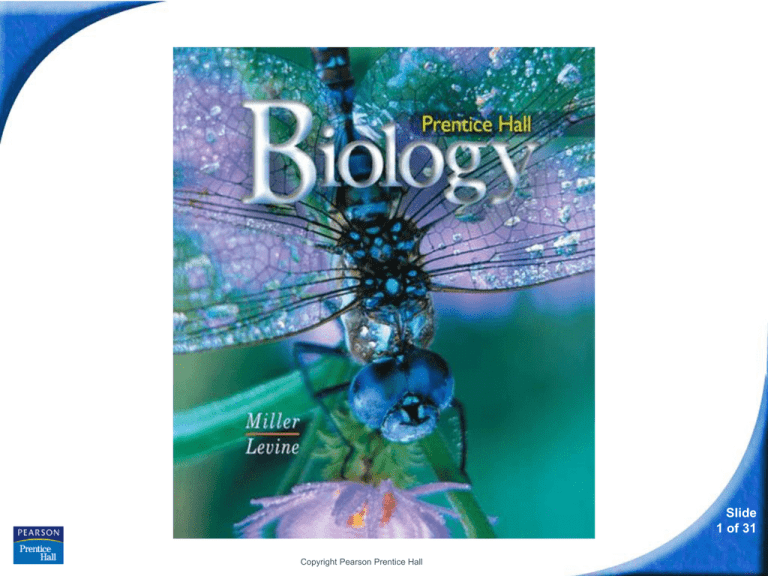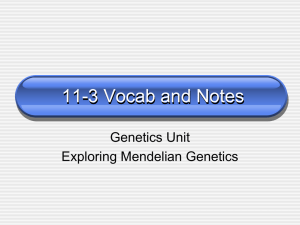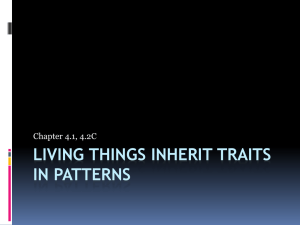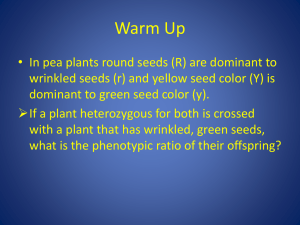
Biology
Slide
1 of 31
Copyright Pearson Prentice Hall
11–3 Exploring Mendelian
Genetics
11-3 Exploring Mendelian Genetics
Slide
2 of 31
Copyright Pearson Prentice Hall
11–3 Exploring Mendelian Genetics
Independent Assortment
What is the principle of independent
assortment?
Slide
3 of 31
Copyright Pearson Prentice Hall
11–3 Exploring Mendelian Genetics
Independent Assortment
Independent Assortment
To determine if the segregation of one pair of
alleles affects the segregation of another pair of
alleles, Mendel performed a two-factor cross.
Slide
4 of 31
Copyright Pearson Prentice Hall
11–3 Exploring Mendelian Genetics
Independent Assortment
The Two-Factor Cross: F1
Mendel crossed true-breeding plants that
produced round yellow peas (genotype RRYY)
with true-breeding plants that produced wrinkled
green peas (genotype rryy).
All of the F1 offspring produced round yellow
peas (RrYy).
Slide
5 of 31
Copyright Pearson Prentice Hall
11–3 Exploring Mendelian Genetics
Independent Assortment
The alleles for round (R) and yellow (Y) are
dominant over the alleles for wrinkled (r) and
green (y).
Slide
6 of 31
Copyright Pearson Prentice Hall
11–3 Exploring Mendelian Genetics
Independent Assortment
The Two-Factor Cross: F2
Mendel crossed the heterozygous F1 plants (RrYy)
with each other to determine if the alleles would
segregate from each other in the F2 generation.
RrYy × RrYy
Slide
7 of 31
Copyright Pearson Prentice Hall
11–3 Exploring Mendelian Genetics
Independent Assortment
The Punnett square predicts a 9 : 3 : 3 :1 ratio in the
F2 generation.
Slide
8 of 31
Copyright Pearson Prentice Hall
11–3 Exploring Mendelian Genetics
Independent Assortment
In Mendel’s experiment, the F2 generation produced
the following:
•
some seeds that were round and yellow
•
some seeds that were wrinkled and green
•
some seeds that were round and green
•
some seeds that were wrinkled and yellow
Slide
9 of 31
Copyright Pearson Prentice Hall
11–3 Exploring Mendelian Genetics
Independent Assortment
The alleles for seed shape segregated independently
of those for seed color. This principle is known as
independent assortment.
Genes that segregate independently do not influence
each other's inheritance.
Slide
10 of 31
Copyright Pearson Prentice Hall
11–3 Exploring Mendelian Genetics
Independent Assortment
Mendel's experimental results were very close to the
9 : 3 : 3 : 1 ratio predicted by the Punnett square.
Mendel had discovered the principle of independent
assortment.
Slide
11 of 31
Copyright Pearson Prentice Hall
11–3 Exploring Mendelian Genetics
Independent Assortment
The principle of independent assortment
states that genes for different traits can
segregate independently during the
formation of gametes.
Independent assortment helps account for
the many genetic variations observed in
plants, animals, and other organisms.
Slide
12 of 31
Copyright Pearson Prentice Hall
11–3 Exploring Mendelian Genetics
A Summary of Mendel's
Principles
A Summary of Mendel's Principles
•
Genes are passed from parents to their
offspring.
•
If two or more forms (alleles) of the gene for a
single trait exist, some forms of the gene may
be dominant and others may be recessive.
Slide
13 of 31
Copyright Pearson Prentice Hall
11–3 Exploring Mendelian Genetics
A Summary of Mendel's
Principles
•
In most sexually reproducing organisms, each
adult has two copies of each gene. These genes
are segregated from each other when gametes
are formed.
•
The alleles for different genes usually segregate
independently of one another.
Slide
14 of 31
Copyright Pearson Prentice Hall
11–3 Exploring Mendelian Genetics
Beyond Dominant and
Recessive Alleles
Beyond Dominant and Recessive Alleles
What inheritance patterns exist aside from
simple dominance?
Slide
15 of 31
Copyright Pearson Prentice Hall
11–3 Exploring Mendelian Genetics
Beyond Dominant and
Recessive Alleles
Some alleles are neither dominant nor
recessive, and many traits are controlled
by multiple alleles or multiple genes.
Slide
16 of 31
Copyright Pearson Prentice Hall
11–3 Exploring Mendelian Genetics
Beyond Dominant and
Recessive Alleles
Incomplete Dominance
When one allele is not completely dominant over
another it is called incomplete dominance.
In incomplete dominance, the heterozygous
phenotype is between the two homozygous
phenotypes.
Slide
17 of 31
Copyright Pearson Prentice Hall
11–3 Exploring Mendelian Genetics
Beyond Dominant and
Recessive Alleles
RR
A cross between
red (RR) and
white (WW) four
o’clock plants
produces pinkcolored flowers
(RW).
WW
Slide
18 of 31
Copyright Pearson Prentice Hall
11–3 Exploring Mendelian Genetics
Beyond Dominant and
Recessive Alleles
Codominance
In codominance, both alleles contribute to the
phenotype.
In certain varieties of chicken, the allele for black
feathers is codominant with the allele for white
feathers.
Heterozygous chickens are speckled with both
black and white feathers. The black and white
colors do not blend to form a new color, but appear
separately.
Slide
19 of 31
Copyright Pearson Prentice Hall
11–3 Exploring Mendelian Genetics
Beyond Dominant and
Recessive Alleles
Multiple Alleles
Genes that are controlled by more than two alleles
are said to have multiple alleles.
An individual can’t have more than two alleles.
However, more than two possible alleles can exist
in a population.
A rabbit's coat color is determined by a single gene
that has at least four different alleles.
Slide
20 of 31
Copyright Pearson Prentice Hall
11–3 Exploring Mendelian Genetics
Beyond Dominant and
Recessive Alleles
Different combinations of alleles result in the colors
shown here.
KEY
C=
full color; dominant
to all other alleles
cch = chinchilla; partial
defect in pigmentation;
dominant to
ch and c alleles
ch = Himalayan; color in
certain parts of the
body; dominant to
c allele
chhc
ch,cCc
h
ch
AIbino:
Chinchilla:
Himalayan:
cc CC,
cc
c,hCc
, or
cch
c,hhor
cch
c
Full color:
, or
Cc
c = albino; no color;
recessive to all other
alleles
Copyright Pearson Prentice Hall
Slide
21 of 31
11–3 Exploring Mendelian Genetics
Beyond Dominant and
Recessive Alleles
Polygenic Traits
Traits controlled by two or more genes are said to
be polygenic traits.
Skin color in humans is a polygenic trait controlled
by more than four different genes.
Slide
22 of 31
Copyright Pearson Prentice Hall
11–3 Exploring Mendelian Genetics
Applying Mendel's
Principles
Applying Mendel's Principles
Thomas Hunt Morgan used fruit flies to advance
the study of genetics.
Morgan and others tested Mendel’s principles and
learned that they applied to other organisms as
well as plants.
Slide
23 of 31
Copyright Pearson Prentice Hall
11–3 Exploring Mendelian Genetics
Applying Mendel's
Principles
Mendel’s principles can be used to study inheritance
of human traits and to calculate the probability of
certain traits appearing in the next generation.
Slide
24 of 31
Copyright Pearson Prentice Hall
11–3 Exploring Mendelian Genetics
Genetics and the
Environment
Genetics and the Environment
Characteristics of any organism are determined by
the interaction between genes and the
environment.
Slide
25 of 31
Copyright Pearson Prentice Hall
11–3
Click to Launch:
Continue to:
- or -
Slide
26 of 31
Copyright Pearson Prentice Hall
11–3
In a cross involving two pea plant traits,
observation of a 9 : 3 : 3 : 1 ratio in the F2
generation is evidence for
a. the two traits being inherited together.
b. an outcome that depends on the sex of the
parent plants.
c. the two traits being inherited independently
of each other.
d. multiple genes being responsible for each
trait.
Copyright Pearson Prentice Hall
Slide
27 of 31
11–3
Traits controlled by two or more genes are called
a. multiple-allele traits.
b. polygenic traits.
c. codominant traits.
d. hybrid traits.
Slide
28 of 31
Copyright Pearson Prentice Hall
11–3
In four o'clock flowers, the alleles for red flowers
and white flowers show incomplete dominance.
Heterozygous four o'clock plants have
a. pink flowers.
b. white flowers.
c. half white flowers and half red flowers.
d. red flowers.
Slide
29 of 31
Copyright Pearson Prentice Hall
11–3
A white male horse and a tan female horse
produce an offspring that has large areas of
white coat and large areas of tan coat. This is
an example of
a. incomplete dominance.
b. multiple alleles.
c. codominance.
d. a polygenic trait.
Slide
30 of 31
Copyright Pearson Prentice Hall
11–3
Mendel's principles apply to
a. pea plants only.
b. fruit flies only.
c. all organisms.
d. only plants and animals.
Slide
31 of 31
Copyright Pearson Prentice Hall
END OF SECTION









